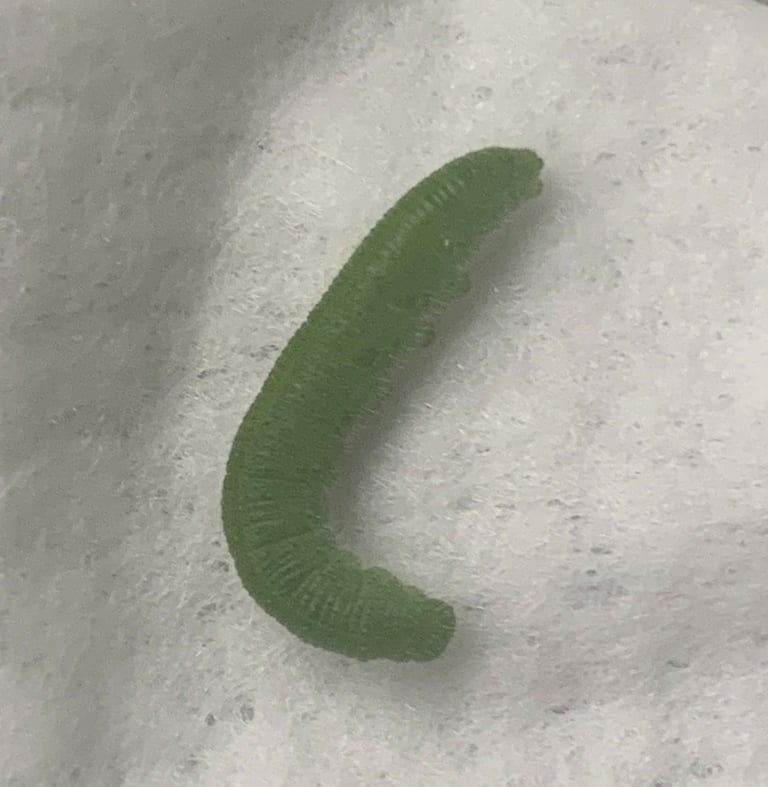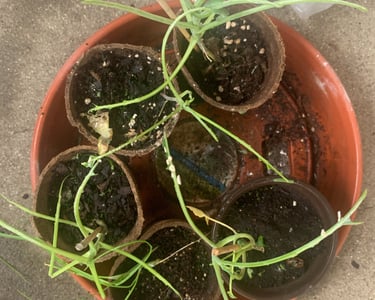Going in Circles with Cabbage Loopers? Take Back Your Greens
Cabbage loopers may be small, but they’re mighty when left unchecked. The good news? With observation, action, and a few natural tricks, you can protect your leafy greens and keep your garden thriving.
GARDEN ISSUESGARDEN PESTS


🐛 Cabbage Loopers: Tiny Pests, Big Problems (and How to Beat Them)
On our porch, we had this big, beautiful broccoli plant growing. One morning, I went out and discovered that my beautiful broccoli plant was beginning to look a little haphazard. The next day was even worse. Admittedly, had I checked the leaves the first day, I would have spotted the culprit cabbage loopers.
Growing leafy greens like Brussels sprouts, cabbage, kale, collards, or broccoli in your urban garden can attract an unwanted visitor. If you notice these unwelcome signs: holes in leaves, frass (insect poop), and green caterpillars hiding in plain sight, its time to take action.
Meet the cabbage looper, a small pest that can cause big damage.
Let’s dig into what they are, how to spot them, and most importantly, how to stop them.
🌿 What Are Cabbage Loopers?
Cabbage loopers are the larval stage (caterpillars) of a moth called Trichoplusia ni. The name comes from their distinctive “looping” movement, imagine an inchworm in overdrive.
They’re particularly fond of anything leafy and green. Below is a list of some of the brassicas (family of vegetables) that they feed on.
Cabbage, Kale, Collards, Broccoli, Cauliflower, Lettuce, Spinach
👀 How to Identify a Cabbage Looper Infestation
Holes in leaves, especially the inner, tender parts
Green caterpillars 1–1.5 inches long, often hiding under leaves
Frass (black or green droppings)
White or gray moths flying low around your plants in the late afternoon or evening
The damage is quick and can be brutal—young plants may not recover if the infestation is severe.
Natural Ways to Control Cabbage Loopers in Urban Gardens
As a new urban grower, you may not know anything about insect control or want to use synthetic sprays, so here are effective, natural methods to help manage cabbage loopers in the garden. If you do decide to use sprays or methods such as diatomaceous earth, remember that you need to follow directions carefully and be aware that beneficial insects can be harmed.
1. Handpicking (Not for the squeamish)
Yep, grab and squish. Visit your garden in the early morning or late afternoon and check under leaves. I've heard some people say that chickens enjoy these pests as treats. Glove wearing is optional. I've used this method, and it is simple, although I must be honest, it's not my favorite.
2. Floating Row Covers
Lightweight fabric can block moths from laying eggs on your plants. Be sure to secure the edges so moths don’t sneak in. Floating row covers can be a good idea for urban gardens and smaller grower business operations. I plan to use this method next year.
3. Neem Oil
A natural pesticide that disrupts the growth of caterpillars. Spray in the early morning or evening, and avoid spraying beneficial insects. I have used this method, and I believe it works, although it can get costly. I used up one bottle on one application to all of my brassicas.
4. BT (Bacillus thuringiensis)
A soil-dwelling bacterium that’s safe for humans and most pollinators but deadly to caterpillars. Spray directly onto leaves where loopers are feeding. I also plan to try this next growing season.
5. Encourage Natural Predators
Invite birds and beneficial insects into your space by planting:
Dill, Fennel, Sweet Alyssum, Marigolds
These plants attract lacewings, parasitic wasps, and ladybugs, loopers’ worst nightmare. I planted some dill, fennel, and marigolds. Birds can also be a bit of a nuisance and messy. I am looking forward to attracting some ladybugs.
Prevention Tips
Rotate crops each season to break pest cycles.
Remove plant debris that may hide eggs or pupae.
Inspect new plants before bringing them into your garden.
Keep a garden journal—note what worked and when pests appeared.
Final Thought
Cabbage loopers may be small, but they’re mighty when left unchecked. The good news? With observation, action, and a few natural tricks, you can protect your leafy greens and keep your garden thriving.
Don’t let the loopers win; your collards deserve better. I'm fighting the good fight myself. I'll let you know the outcome.




